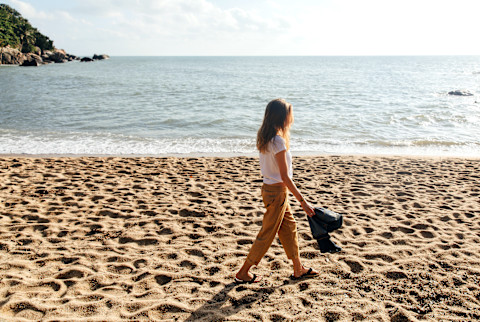How I Became Vitamin D Deficient When I Was Living By The Beach

The weather in Charleston, South Carolina, is fantastic. I lived there for four years, and I only saw snow once (it was less than an inch). Most days, the sun is shining, and the salty breeze is blowing; I spent most of my weekends lounging around on Folly Beach.
That doesn't exactly sound like a recipe for a vitamin D—also known as the "sunshine" vitamin—deficiency, does it?
And yet, I was diagnosed with a deficiency in that very vitamin while I was attending the College of Charleston. To this day, I'm not sure how that happened—considering my love of the sun and substantial free time (it was college, after all)—so I tracked down the doctor who first uncovered my deficiency to get her two cents.
After sitting down with Jessica Hayman, N.D., a naturopathic doctor and founder of Verde Valle Naturopathic in my hometown of Sedona, Arizona, I realized there was still a lot to learn about vitamin D, how we're supposed to get it, and why we should all be wary of our levels regardless of climate.
How you can still have a vitamin D deficiency, even if you get plenty of sun.
"If they're not supplementing, I'd say 90% of my patients' vitamin D levels aren't in the optimal range," says Hayman. Luckily, a vitamin D test is part of her standard lab work, so she checks almost every patient for a deficiency and recommends a supplement if they're low.
We're supposed to get our vitamin D from a combination of the sun and foods high in vitamin D, but that doesn't always go as planned. For one, vitamin-D-rich foods include fatty fish, beef liver, and oysters, which—let's be honest—most of us aren't eating daily.
According to Hayman, our indoor lifestyles and habit of putting sunscreen on whenever we'll be outside are also to blame.
But what about me, a girl who was spending hours outdoors every single day? According to Hayman, your vitamin D levels can still be low if you're in the sun. In fact, even in Sedona, tons of people are deficient. "Living in the desert in Arizona, you would think that everyone would have optimal vitamin D levels, but it's simply not true," she says.
The reference range for blood vitamin D levels is 30 to 100 ng/mL, but most patients come in with levels in the 20 to 30 ng/mL range, and Hayman works to get them up to somewhere between 50 and 70 ng/mL.
So should everyone—regardless of climate—get tested for a vitamin D deficiency? According to Hayman, "Definitely. Because even people who are active and spending a lot of time outside can have low levels."
How to get vitamin D from sources beyond the sun.
There's a lot of fuss over vitamin D in the wellness world, and despite the fact that I've been supplementing for years, I wasn't sure why, exactly, this vitamin is so important for our health. "It's necessary for bone health," explains Hayman.
To correct a deficiency, she recommends a vitamin D3 supplement, as most studies have shown1 it's more effective at increasing blood vitamin D levels. Oftentimes, she'll suggest taking a higher "therapeutic dose" for a month and then backing off to a "maintenance dose" for two more months before retests to make sure levels are improving. "But it really depends on the patient," she says.
If you're concerned about your vitamin D levels, Hayman recommends getting them tested and working with a health care professional, so you know exactly what dose to use. "You don't want to take too much," she says, explaining that although it's extremely rare, it can cause headaches, muscle pain, and fatigue, or even more serious liver problems when taken at very high levels.
So whether your home base is the cloud-covered Pacific Northwest or perpetually sunny South Florida, vitamin D is one of the supplements you should always have in your medicine cabinet. The good news is that it's inexpensive, completely tasteless, and easy to add to your routine.

